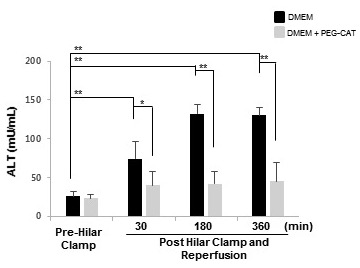Direct Intrahepatic Delivery of Pegylated-Catalase Is Protective in a Rat Ischemia-Reperfusion Injury Model.
1Department of Surgery, Division of Transplant, The Ohio State University Wexner Medical Center, Columbus, OH
2Center for Vaccines and Immunity, The Research Institute at Nationwide Childrens Hospital, Columbus, OH
3Departments of Pediatrics and Internal Medicine, The Ohio State University College of Medicine, Columbus, OH
Meeting: 2017 American Transplant Congress
Abstract number: A159
Keywords: Ischemia, Liver transplantation, Warm ischemia
Session Information
Session Name: Poster Session A: Ischemic Injury and Organ Preservation Session I
Session Type: Poster Session
Date: Saturday, April 29, 2017
Session Time: 5:30pm-7:30pm
 Presentation Time: 5:30pm-7:30pm
Presentation Time: 5:30pm-7:30pm
Location: Hall D1
Introduction: Ischemia-reperfusion injury (IRI) is characterized by cessation of blood flow to an organ or tissue leading to accumulation of toxic metabolites and free radicals, known as reactive oxygen species. Catalase is an endogenous enzyme involved in H2O2 detoxification. We hypothesize that the delivery of polyethylene glycol-catalase (PEG-CAT), directly targeted to the liver during ischemia would significantly reduce IRI.
Methods and Materials: To characterize the mechanism of protection, endothelial cells and hepatocytes were treated with PEG-CAT using a H2O2 based model of oxidative stress. A 70% rat liver hilar clamp model with catheter based segmental intrahepatic delivery was used to validate the ability of PEG-CAT to mitigate IRI at the organ level.
Results:. Endothelial cells and hepatocytes treated with PEG-CAT demonstrated significantly increased catalase activity, reduced cell toxicity, decreased LDH, and decreased apoptosis. Mitochondrial membrane potential was maintained in endothelial cells treated with H2O2 and PEG-CAT, as demonstrated by JC-1 staining. The intrahepatic segmental hilar clamp model of IRI demonstrated significantly decreased serum ALT (Figure 1), AST and MDA, with improved maintenance of ATP and glutathione in livers treated with PEG-CAT.
Conclusions: In cells, treatment with PEG-CAT is capable of decreasing H2O2 cytotoxicity, with maintenance of cellular metabolism. Catheter based intrahepatic delivery of PEG-CAT mitigates hepatic IRI. Potential applications of PEG-CAT using this methodology exist for hepatic surgery and liver transplantation. PEG-CAT could be used to pre-treat a donor organ either immediately after explantation via an ex-vivo perfusion circuit prior to transplantation to treat existing injury and to prevent reperfusion injury.
CITATION INFORMATION: Beal E, Black S, Kim J, Velazquez V, Washburn K, Hayes Jr. D, Whitson B. Direct Intrahepatic Delivery of Pegylated-Catalase Is Protective in a Rat Ischemia-Reperfusion Injury Model. Am J Transplant. 2017;17 (suppl 3).
To cite this abstract in AMA style:
Beal E, Black S, Kim J, Velazquez V, Washburn K, Jr DHayes, Whitson B. Direct Intrahepatic Delivery of Pegylated-Catalase Is Protective in a Rat Ischemia-Reperfusion Injury Model. [abstract]. Am J Transplant. 2017; 17 (suppl 3). https://atcmeetingabstracts.com/abstract/direct-intrahepatic-delivery-of-pegylated-catalase-is-protective-in-a-rat-ischemia-reperfusion-injury-model/. Accessed December 14, 2025.« Back to 2017 American Transplant Congress
